java实验最终版
- 格式:doc
- 大小:4.57 MB
- 文档页数:47
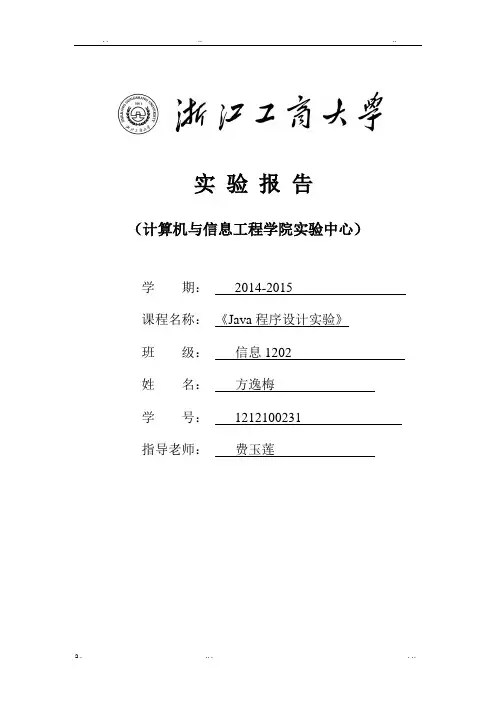
实验报告(计算机与信息工程学院实验中心)学期:2014-2015课程名称:《Java程序设计实验》班级:信息1202姓名:方逸梅学号:1212100231指导老师:费玉莲《Java程序设计》独立实验教学安排一、实验的教学方式、安排及实验环境(一)教学方式对照本课程的实验教材,实验一至实验十一,由教师提示实验原理、方法、步骤等内容,在教师的指导下,学生独立完成程序设计及调试工作。
实验十二的内容由学生自行设计完成。
(二)教学安排学时数:30课时学时安排:每次实验3学时,从学期第五周开始,共十次上机实验。
(三)实验环境实验环境为JDK 1.6。
(四)具体安排地点:信息大楼实验室。
辅导:每个班次一名辅导老师,原则上由任课老师担任。
登记:实验完成,由辅导老师登记实验纪录。
学生:实验做完,完成实验报告内容,并在学期末上交实验册。
老师:批改实验,成绩与平时成绩一起占期末的30%。
二、实验的具体内容和要求见实验报告。
浙江工商大学计算机与信息工程学院实验报告(1)日期:地点:成绩:━━━━━━━━━━━━━━━━━━━━━━━━━━━━━━━━━━━━━━━实验目的、实验原理和内容:一、实验目的:熟悉Java开发环境及简单程序Java设计。
二、实验原理:SDK 的下载与安装,设置环境变量,安装java 虚拟机,使用Eclipse,编译Java 源程序,运行Java 程序。
三、实验内容及要求:1.下载、安装并设置Java SDK 软件包。
2.熟悉Eclipse编辑软件。
3.掌握运行Java 程序的步骤。
4.分别编写Application和Applet程序,显示字符串”Hello Java!欢迎使用!”。
要求:请同学把预备知识、步骤、程序框图、调试好的程序及存在的问题写在下面(不够可以附页)。
程序一public class hello {public static void main(String[] args) {for(int i=0;i<=4;i++){System.out.println("Hello java! 欢迎使用!");}}}结果示意图1存在的问题1、JA VA 存在大小写,因为system没有区分大小写所以出现编译错误。
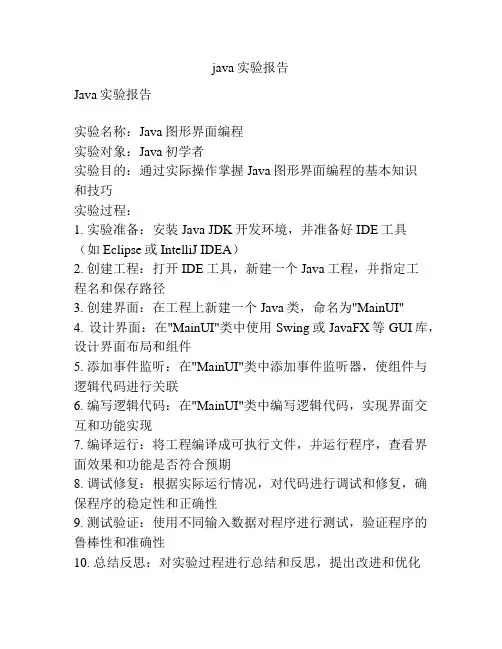
java实验报告Java实验报告实验名称:Java图形界面编程实验对象:Java初学者实验目的:通过实际操作掌握Java图形界面编程的基本知识和技巧实验过程:1. 实验准备:安装Java JDK开发环境,并准备好IDE工具(如Eclipse或IntelliJ IDEA)2. 创建工程:打开IDE工具,新建一个Java工程,并指定工程名和保存路径3. 创建界面:在工程上新建一个Java类,命名为"MainUI"4. 设计界面:在"MainUI"类中使用Swing或JavaFX等GUI库,设计界面布局和组件5. 添加事件监听:在"MainUI"类中添加事件监听器,使组件与逻辑代码进行关联6. 编写逻辑代码:在"MainUI"类中编写逻辑代码,实现界面交互和功能实现7. 编译运行:将工程编译成可执行文件,并运行程序,查看界面效果和功能是否符合预期8. 调试修复:根据实际运行情况,对代码进行调试和修复,确保程序的稳定性和正确性9. 测试验证:使用不同输入数据对程序进行测试,验证程序的鲁棒性和准确性10. 总结反思:对实验过程进行总结和反思,提出改进和优化的建议实验结果:通过实验,我成功创建了一个简单的Java图形界面程序,并实现了基本的交互和功能。
在界面设计方面,我使用了Swing库进行布局和组件的添加,通过事件监听器实现了按钮点击和文本框输入的监听。
在逻辑代码方面,我实现了简单的计算器功能,能够进行加减乘除等基本运算。
通过测试验证,程序运行稳定,结果准确。
实验心得:通过这次实验,我对Java图形界面编程有了更深入的了解和掌握。
我学会了使用Swing或JavaFX等库进行界面设计,以及如何添加事件监听器和编写逻辑代码。
通过实际操作,我发现编写图形界面程序相对于命令行程序更加复杂,需要考虑到用户的交互和界面布局,还需要注意代码的可读性和可维护性。
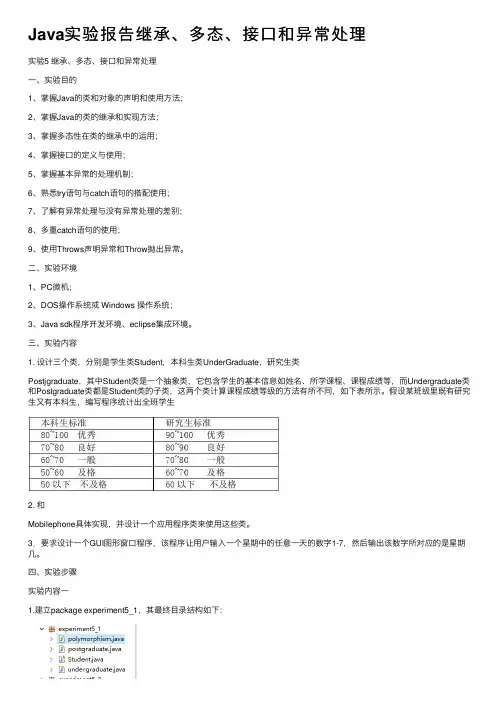
Java实验报告继承、多态、接⼝和异常处理实验5 继承、多态、接⼝和异常处理⼀、实验⽬的1、掌握Java的类和对象的声明和使⽤⽅法;2、掌握Java的类的继承和实现⽅法;3、掌握多态性在类的继承中的运⽤;4、掌握接⼝的定义与使⽤;5、掌握基本异常的处理机制;6、熟悉try语句与catch语句的搭配使⽤;7、了解有异常处理与没有异常处理的差别;8、多重catch语句的使⽤;9、使⽤Throws声明异常和Throw抛出异常。
⼆、实验环境1、PC微机;2、DOS操作系统或 Windows 操作系统;3、Java sdk程序开发环境、eclipse集成环境。
三、实验内容1. 设计三个类,分别是学⽣类Student,本科⽣类UnderGraduate,研究⽣类Postjgraduate,其中Student类是⼀个抽象类,它包含学⽣的基本信息如姓名、所学课程、课程成绩等,⽽Undergraduate类和Postgraduate类都是Student类的⼦类,这两个类计算课程成绩等级的⽅法有所不同,如下表所⽰。
假设某班级⾥既有研究⽣⼜有本科⽣,编写程序统计出全班学⽣2. 和Mobilephone具体实现,并设计⼀个应⽤程序类来使⽤这些类。
3.要求设计⼀个GUI图形窗⼝程序,该程序让⽤户输⼊⼀个星期中的任意⼀天的数字1-7,然后输出该数字所对应的是星期⼏。
四、实验步骤实验内容⼀1.建⽴package experiment5_1,其最终⽬录结构如下:2.建⽴Student类:package experiment5_1;public abstract class Student {final static int CourseNo = 3;String name;String type;int[] courses;String courseGrade;public Student(String name) {/doc/1bd4a299a66e58fafab069dc5022aaea998f41e2.html = name; courses = new int[CourseNo];courseGrade = "" ;}public abstract void calculateGrade();public String getName( ) {return name;}public String getType( ) {return type ;}public String getCourseGrade( ) {return courseGrade;}public int getCourseScore(int courseNumber) {return courses[courseNumber];}public void setName(String name) {/doc/1bd4a299a66e58fafab069dc5022aaea998f41e2.html = name;}public void setType(String type) {this.type = type;}public void setCourseScore(int courseNumber, int courseScore) { //按课程索引号设置课程成绩this.courses[courseNumber] = courseScore ;}}3.建⽴外部类(1)研究⽣类Postjgraduatepackage experiment5_1;public class postgraduate extends Student {public postgraduate(String name) {super(name);type = "研究⽣";}public void calculateGrade() {// TODO Auto-generated method stubint total = 0;double average = 0;for (int i = 0; i < CourseNo; i++) {total += courses[i];};average = total / CourseNo;if (average>=90&&average<100) courseGrade = "优秀"; else if (average>=80&&average<90) courseGrade = "良好"; else if (average>=70&&average<80) courseGrade = "⼀般"; else if (average>=60&&average<70) courseGrade = "及格"; else courseGrade = "不及格";}}(2)本科⽣类UnderGraduatepackage experiment5_1;public class undergraduate extends Student {public undergraduate(String name ) {super(name);type = "本科⽣";}public void calculateGrade() {int total = 0;double average = 0;for (int i = 0; i < CourseNo; i++) {total += getCourseScore(i) ;};average = total / CourseNo;if (average>=80&&average<100) courseGrade = "优秀"; else if (average>=70&&average<80) courseGrade = "良好"; else if (average>=60&&average<70) courseGrade = "⼀般"; else if (average>=50&&average<60) courseGrade = "及格"; else courseGrade = "不及格";}}4.编写代码测试函数package experiment5_1;public class polymorphism {public static void main(String[] args) {Student[] students = new Student[5];students[0] = new undergraduate("陈建平");students[1] = new undergraduate("鲁向东");students[2] = new postgraduate("匡晓华");students[3] = new undergraduate("周丽娜");students[4] = new postgraduate("梁欣欣");for (int i=0; i<5 ;i++) {students[i].setCourseScore(0,87);students[i].setCourseScore(1,90);students[i].setCourseScore(2,78);}for (int i=0; i<5 ;i++) {students[i].calculateGrade();}System.out.println("姓名" + " 类型" +" 成绩");System.out.println("-----------------------");for (int i=0; i<5 ;i++) {System.out.println(students[i].getName( )+" "+students[i].getType( )+" "+students[i].getCourseGrade( ));}}}实验内容⼆1.建⽴package experiment5_2,其最终⽬录结构如下:2.写接⼝Soundable代码:package experiment5_2;public interface Soundable {public void increaseV olume( );public void decreaseV olume( );public void stopSound( );public void playSound( );}3.创建三个类Radio、Walkman和Mobilephone具体实现,分别添加代码:// Mobilephone类package experiment5_2;class Mobilephone implements Soundable{public void increaseV olume( ) {System.out.println("增⼤⼿机⾳量");}public void decreaseV olume( ) {System.out.println("减⼩⼿机⾳量");}public void stopSound( ) {System.out.println("关闭⼿机");}public void playSound( ) {System.out.println("⼿机发出来电铃声");}}// Walkman类package experiment5_2;class Walkman implements Soundable { public void increaseV olume( ) { System.out.println("增⼤随声听⾳量"); }public void decreaseV olume( ) { System.out.println("减⼩随声听⾳量"); }public void stopSound( ) {System.out.println("关闭随声听");}public void playSound( ) {System.out.println("随声听发出⾳乐"); }}// Radio类package experiment5_2;class Radio implements Soundable{ public void increaseV olume( ) { System.out.println("增⼤收⾳机⾳量"); }public void decreaseV olume( ) { System.out.println("减⼩收⾳机⾳量"); }public void stopSound( ) {System.out.println("关闭收⾳机");}public void playSound( ) {System.out.println("收⾳机播放⼴播"); }}4.创建people类及编写测试代码://People类package experiment5_2;class People {public void listen(Soundable s) {s.playSound( );}}//测试代码package experiment5_2;import java.util.Scanner;public class InterfaceTest {public static void main(String[] args) {int i;People sportsman = new People( );Scanner scanner = new Scanner(System.in);Soundable[] soundDevice = new Soundable[3];//往声⾳设备数组中放⼊能发声的设备soundDevice[0] = new Radio( );soundDevice[1] = new Walkman( );soundDevice[2] = new Mobilephone();System.out.println("你想听什么? 请输⼊选择:0-收⾳机1-随声听2-⼿机");i = scanner.nextInt( );//开始听声⾳sportsman.listen(soundDevice[i]);soundDevice[i].increaseV olume( );soundDevice[i].stopSound();scanner.close();}}实验内容三1.建⽴package experiment5_3,其最终⽬录结构如下package experiment5_3;import java.awt.*;import java.awt.event.*;import javax.swing.*;public class DateTransf extends JFrame implements KeyListener{/****/private static final long serialVersionUID = 1L;private static DateTransf frm;private static JTextField txt;private static JTextField data;DateTransf() {setTitle("数字与星期转换");setLocation(700, 300);setSize(400,130);}public static void main(String[] args) {frm = new DateTransf();frm.setDefaultCloseOperation(JFrame.EXIT_ON_CLOSE);frm.setLayout(new GridLayout(2,2));txt = new JTextField(12);data = new JTextField(12);JLabel lable1 = new JLabel("输⼊数字:");JLabel lable2 = new JLabel("星期⼏:");frm.add(lable1);txt.addKeyListener(frm);frm.add(txt);frm.add(lable2);frm.add(data);frm.setVisible(true);}public void keyPressed(KeyEvent e) {if (e.getSource() == txt) {if (e.getKeyCode() == KeyEvent.VK_ENTER) // 判断按下的键是否是回车键{try {int number = Integer.parseInt(txt.getText());switch (number) {case 1:data.setText("Mon");break;case 2:data.setText("Tue");break;case 3:data.setText("Wen");break;case 4:data.setText("Thu");break;case 5:data.setText("Fri");break;case 6:data.setText("Sat");break;case 7:data.setText("Sun");break;default:JOptionPane.showMessageDialog(null, "您输⼊的数字不是1~7","⽆效⽇期",/doc/1bd4a299a66e58fafab069dc5022aaea998f41e2.html RMATION_MESSAGE); break;}}catch (Exception e1) {// TODO: handle exceptionJOptionPane.showMessageDialog(null, "您输⼊的不是整数","⽆效⽇期",/doc/1bd4a299a66e58fafab069dc5022aaea998f41e2.html RMA TION_MESSAGE); }}}}public void keyReleased(KeyEvent e) {}public void keyTyped(KeyEvent e) {}}2.编译运⾏五、实验结果●实验内容⼀结果:●实验内容⼆结果:●实验内容三结果:六、实验⼩结1.这次实验的内容⽐较多,需要掌握Java的类和对象的声明和使⽤⽅法、Java的类的继承和实现⽅法、多态性在类的继承中的运⽤、接⼝的定义与使⽤、基本异常的处理机制、try语句与catch语句的搭配使⽤等等;2. 在实验过程中,重点是要区分好实例和类,灵活掌握类的调⽤。
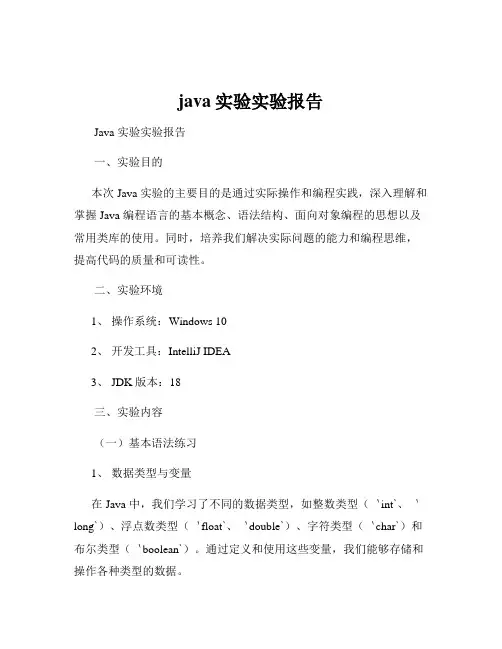
java实验实验报告Java 实验实验报告一、实验目的本次 Java 实验的主要目的是通过实际操作和编程实践,深入理解和掌握 Java 编程语言的基本概念、语法结构、面向对象编程的思想以及常用类库的使用。
同时,培养我们解决实际问题的能力和编程思维,提高代码的质量和可读性。
二、实验环境1、操作系统:Windows 102、开发工具:IntelliJ IDEA3、 JDK 版本:18三、实验内容(一)基本语法练习1、数据类型与变量在 Java 中,我们学习了不同的数据类型,如整数类型(`int`、`long`)、浮点数类型(`float`、`double`)、字符类型(`char`)和布尔类型(`boolean`)。
通过定义和使用这些变量,我们能够存储和操作各种类型的数据。
```javaint age = 25;double salary = 500050;char grade ='A';boolean isStudent = true;```2、控制结构包括条件语句(`ifelse`、`switch`)和循环语句(`for`、`while`、`dowhile`)。
这些控制结构使我们能够根据不同的条件执行不同的代码块,或者重复执行一段代码。
```javaint num = 10;if (num > 5) {Systemoutprintln("Number is greater than 5");} else {Systemoutprintln("Number is less than or equal to 5");}switch (num) {Systemoutprintln("One");break;case 10:Systemoutprintln("Ten");break;default:Systemoutprintln("Unknown");}for (int i = 0; i < 5; i++){Systemoutprintln(i);}int count = 0;while (count < 3) {Systemoutprintln("Count: "+ count);count++;}count = 0;Systemoutprintln("Count: "+ count);count++;} while (count < 3);```(二)面向对象编程1、类与对象创建了自定义的类来表示现实世界中的实体。
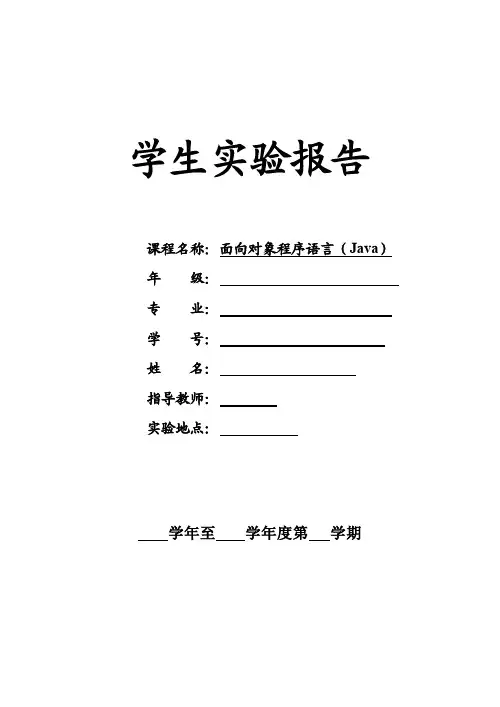
学生实验报告课程名称:面向对象程序语言(Java)年级:专业:学号:姓名:指导教师:实验地点:学年至学年度第学期1.目录实验一初识Java——“一个简单的应用程序”实验二基本数据类型与数组——“输出希腊字母表”实验三分支与循环语句——“猜数字游戏”实验四类与对象——“机动车”实验五类与对象——“家中的电视”实验六类与对象——“共饮同井水”实验七类与对象——“求方程的根”实验八子类与继承——“中国人、北京人和美国人”实验九子类与继承——“银行计算利息”实验十子类与继承——“公司支出的总薪水”实验十一接口与实现——“评价成绩”实验十二内部类与异常类——“检查危险品”实验十三常用实用类——“检索简历”实验十四组件及时间处理——“计算三角形的面积”实验十五实验十六实验(一)初识Java——“一个简单的应用程序”实验时间:2017年02月21日实验目的本实验的目的是让学生掌握开发Java应用程序的三个步骤:编写源文件、编译源文件和运行应用程序实验要求编写一个简单的Java应用程序,该程序在命令行窗口输出两行文字:“你好,欢迎学习Java”和“We are students”。
实验内容public class Hello {public static void main (String args[ ]) {System.out.println("你好,很高兴学习Java"); //命令行窗口输出"你好,很高兴学习Java"A a=new A();a.fA();}}class A {void fA() {System.out.println("We are students"); //命令行窗口输出"We are students"}}实验结果分析通过本次实验,在老师的指导下我学会了基本的JAVA编译原理,能够自行改变环境变量,能够成功编译出一个简单的应用程序,而且通过实验后的练习知道了一些基础的错误在JAVA中出现时编译器的提示信息是怎样的。
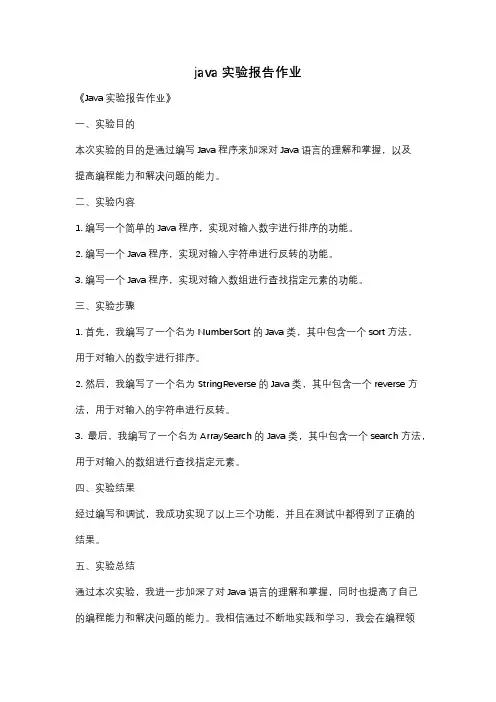
java实验报告作业
《Java实验报告作业》
一、实验目的
本次实验的目的是通过编写Java程序来加深对Java语言的理解和掌握,以及
提高编程能力和解决问题的能力。
二、实验内容
1. 编写一个简单的Java程序,实现对输入数字进行排序的功能。
2. 编写一个Java程序,实现对输入字符串进行反转的功能。
3. 编写一个Java程序,实现对输入数组进行查找指定元素的功能。
三、实验步骤
1. 首先,我编写了一个名为NumberSort的Java类,其中包含一个sort方法,
用于对输入的数字进行排序。
2. 然后,我编写了一个名为StringReverse的Java类,其中包含一个reverse方法,用于对输入的字符串进行反转。
3. 最后,我编写了一个名为ArraySearch的Java类,其中包含一个search方法,用于对输入的数组进行查找指定元素。
四、实验结果
经过编写和调试,我成功实现了以上三个功能,并且在测试中都得到了正确的
结果。
五、实验总结
通过本次实验,我进一步加深了对Java语言的理解和掌握,同时也提高了自己
的编程能力和解决问题的能力。
我相信通过不断地实践和学习,我会在编程领
域取得更大的进步。
同时,我也意识到在编写程序时要注重细节,以确保程序的正确性和稳定性。
希望在今后的学习和工作中能够不断提升自己,成为一名优秀的程序员。
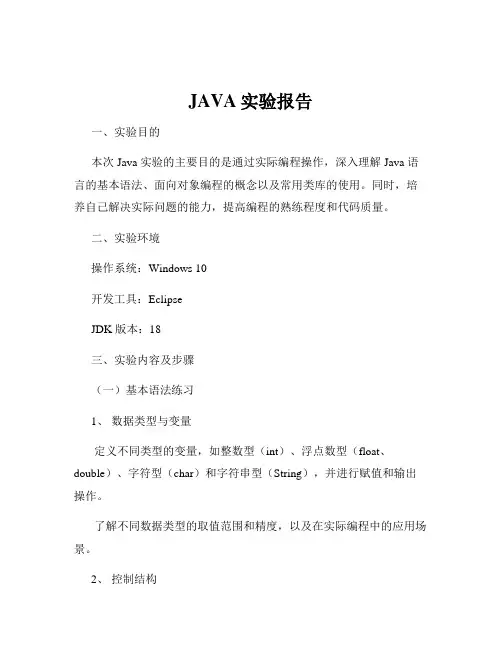
JAVA实验报告一、实验目的本次 Java 实验的主要目的是通过实际编程操作,深入理解 Java 语言的基本语法、面向对象编程的概念以及常用类库的使用。
同时,培养自己解决实际问题的能力,提高编程的熟练程度和代码质量。
二、实验环境操作系统:Windows 10开发工具:EclipseJDK 版本:18三、实验内容及步骤(一)基本语法练习1、数据类型与变量定义不同类型的变量,如整数型(int)、浮点数型(float、double)、字符型(char)和字符串型(String),并进行赋值和输出操作。
了解不同数据类型的取值范围和精度,以及在实际编程中的应用场景。
2、控制结构编写使用 ifelse 语句、switch 语句进行条件判断的程序。
运用 for 循环、while 循环和 dowhile 循环实现重复执行的操作。
3、数组与字符串声明和初始化一维数组和二维数组,对数组元素进行访问和操作。
进行字符串的拼接、截取、查找等常见操作。
(二)面向对象编程实践1、类与对象定义一个简单的类,包含属性和方法。
创建该类的对象,并调用对象的方法来操作属性。
2、继承与多态建立父类和子类,实现继承关系。
在子类中重写父类的方法,展示多态性。
3、封装与抽象将类的属性设置为私有,并提供公共的访问方法(getter 和 setter),实现封装。
定义抽象类和抽象方法,体会抽象的概念和作用。
(三)常用类库的使用1、 Java 输入输出(IO)使用 Scanner 类实现从控制台读取用户输入的数据。
运用 File 类和相关的输入输出流类,实现文件的读取和写入操作。
2、集合框架熟悉 ArrayList、LinkedList 等线性集合的使用方法。
了解 HashSet、TreeSet 等集合的特点和应用场景。
3、异常处理在程序中加入可能引发异常的代码段,并使用 trycatch 语句捕获和处理异常。
四、实验结果与分析(一)基本语法练习1、数据类型与变量成功定义了各种数据类型的变量,并正确进行了赋值和输出。
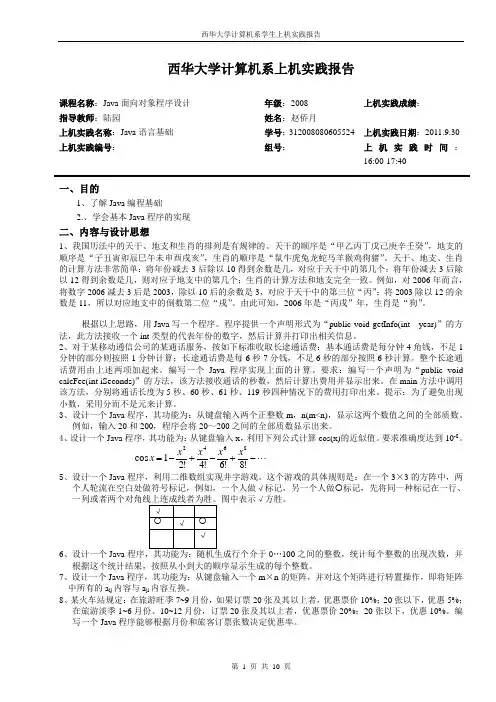
西华大学计算机系上机实践报告课程名称:Java 面向对象程序设计 年级:2008 上机实践成绩: 指导教师:陆园姓名:赵侨月上机实践名称:Java 语言基础 学号:312008********* 上机实践日期:2011.9.30上机实践编号: 组号:上机实践时间:16:00-17:40一、目的1、了解Java 编程基础2.、学会基本Java 程序的实现二、内容与设计思想1、我国历法中的天干、地支和生肖的排列是有规律的。
天干的顺序是“甲乙丙丁戊己庚辛壬癸”,地支的顺序是“子丑寅卯辰巳午未申酉戌亥”,生肖的顺序是“鼠牛虎兔龙蛇马羊猴鸡狗猪”。
天干、地支、生肖的计算方法非常简单:将年份减去3后除以10得到余数是几,对应于天干中的第几个;将年份减去3后除以12得到余数是几,则对应于地支中的第几个;生肖的计算方法和地支完全一致。
例如,对2006年而言,将数字2006减去3后是2003,除以10后的余数是3,对应于天干中的第三位“丙”;将2003除以12的余数是11,所以对应地支中的倒数第二位“戌”。
由此可知,2006年是“丙戌”年,生肖是“狗”。
根据以上思路,用Java 写一个程序。
程序提供一个声明形式为“public void getInfo(int year)”的方法,此方法接收一个int 类型的代表年份的数字,然后计算并打印出相关信息。
2、对于某移动通信公司的某通话服务,按如下标准收取长途通话费:基本通话费是每分钟4角钱,不足1分钟的部分则按照1分钟计算;长途通话费是每6秒7分钱,不足6秒的部分按照6秒计算。
整个长途通话费用由上述两项加起来。
编写一个Java 程序实现上面的计算。
要求:编写一个声明为“public void calcFee(int iSeconds)”的方法,该方法接收通话的秒数,然后计算出费用并显示出来。
在main 方法中调用该方法,分别将通话长度为5秒、60秒、61秒、119秒四种情况下的费用打印出来。
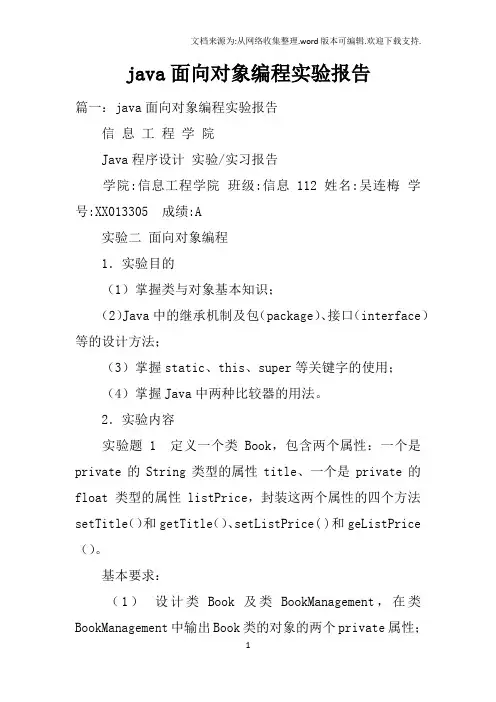
java面向对象编程实验报告篇一:java面向对象编程实验报告信息工程学院Java程序设计实验/实习报告学院:信息工程学院班级:信息112 姓名:吴连梅学号:XX013305 成绩:A实验二面向对象编程1.实验目的(1)掌握类与对象基本知识;(2)Java中的继承机制及包(package)、接口(interface)等的设计方法;(3)掌握static、this、super等关键字的使用;(4)掌握Java中两种比较器的用法。
2.实验内容实验题 1 定义一个类Book,包含两个属性:一个是private的String类型的属性title、一个是private的float类型的属性listPrice,封装这两个属性的四个方法setTitle()和getTitle()、setListPrice( )和geListPrice ()。
基本要求:(1)设计类Book及类BookManagement,在类BookManagement中输出Book类的对象的两个private属性;(2)重写父类的toString()方法,实现Book类实例的两个属性的输出。
实验过程:新建工程后,在工程下面建立一个包Book,在包下再建立一个Book类,类中包含两个属性,一个是private的String类型的属性title、一个是private的float类型的属性listPrice,之后是封装这两个属性的四个方法,用快捷键Alt+Shift+S选择gennerate Getters and Setters,再实验报告的内容与格式按任课教师的要求书写。
然后就是重写父类的toString()方法,用快捷键Alt+Shift+S选择gennerate toString,快捷重写。
这段程序写完是这样的:接下来便是BookManagement类,在包book下新建一个类BookManagement,写完的程序是这样的:BookManagement类中创建了书的对象,在主方法中调用output函数,赋值,输出。
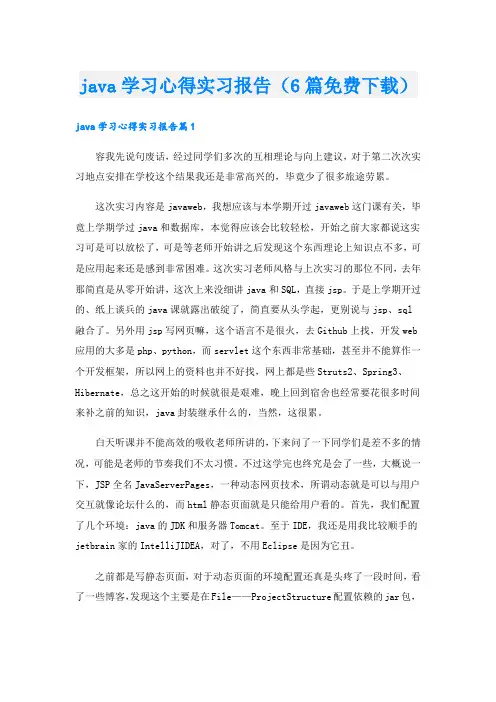
java学习心得实习报告(6篇免费下载)java学习心得实习报告篇1容我先说句废话,经过同学们多次的互相理论与向上建议,对于第二次次实习地点安排在学校这个结果我还是非常高兴的,毕竟少了很多旅途劳累。
这次实习内容是javaweb,我想应该与本学期开过javaweb这门课有关,毕竟上学期学过java和数据库,本觉得应该会比较轻松,开始之前大家都说这实习可是可以放松了,可是等老师开始讲之后发现这个东西理论上知识点不多,可是应用起来还是感到非常困难。
这次实习老师风格与上次实习的那位不同,去年那简直是从零开始讲,这次上来没细讲java和SQL,直接jsp。
于是上学期开过的、纸上谈兵的java课就露出破绽了,简直要从头学起,更别说与jsp、sql 融合了。
另外用jsp写网页嘛,这个语言不是很火,去Github上找,开发web 应用的大多是php、python,而servlet这个东西非常基础,甚至并不能算作一个开发框架,所以网上的资料也并不好找,网上都是些Struts2、Spring3、Hibernate,总之这开始的时候就很是艰难,晚上回到宿舍也经常要花很多时间来补之前的知识,java封装继承什么的,当然,这很累。
白天听课并不能高效的吸收老师所讲的,下来问了一下同学们是差不多的情况,可能是老师的节奏我们不太习惯。
不过这学完也终究是会了一些,大概说一下,JSP全名JavaServerPages,一种动态网页技术,所谓动态就是可以与用户交互就像论坛什么的,而html静态页面就是只能给用户看的。
首先,我们配置了几个环境:java的JDK和服务器Tomcat。
至于IDE,我还是用我比较顺手的jetbrain家的IntelliJIDEA,对了,不用Eclipse是因为它丑。
之前都是写静态页面,对于动态页面的环境配置还真是头疼了一段时间,看了一些博客,发现这个主要是在File——ProjectStructure配置依赖的jar包,还有就是tomcat服务器的配置。
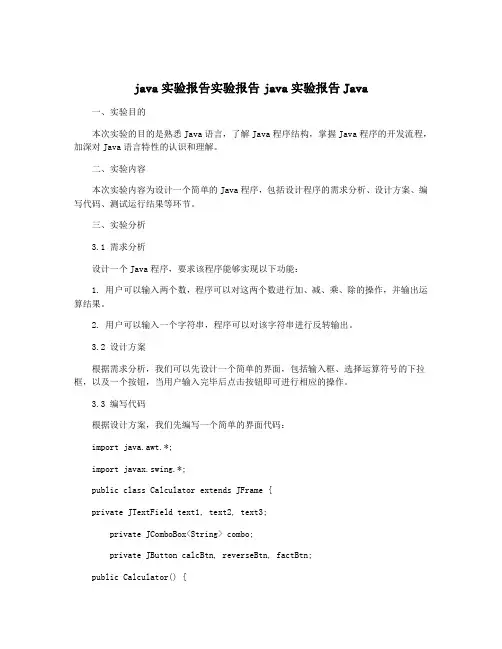
java实验报告实验报告java实验报告Java一、实验目的本次实验的目的是熟悉Java语言,了解Java程序结构,掌握Java程序的开发流程,加深对Java语言特性的认识和理解。
二、实验内容本次实验内容为设计一个简单的Java程序,包括设计程序的需求分析、设计方案、编写代码、测试运行结果等环节。
三、实验分析3.1 需求分析设计一个Java程序,要求该程序能够实现以下功能:1. 用户可以输入两个数,程序可以对这两个数进行加、减、乘、除的操作,并输出运算结果。
2. 用户可以输入一个字符串,程序可以对该字符串进行反转输出。
3.2 设计方案根据需求分析,我们可以先设计一个简单的界面,包括输入框、选择运算符号的下拉框,以及一个按钮,当用户输入完毕后点击按钮即可进行相应的操作。
3.3 编写代码根据设计方案,我们先编写一个简单的界面代码:import java.awt.*;import javax.swing.*;public class Calculator extends JFrame {private JTextField text1, text2, text3;private JComboBox<String> combo;private JButton calcBtn, reverseBtn, factBtn;public Calculator() {super("Calculator");text1 = new JTextField(5);text2 = new JTextField(5);text3 = new JTextField(10);combo = new JComboBox<String>(new String[]{"+", "-", "*", "/"});calcBtn = new JButton("Calculate");reverseBtn = new JButton("Reverse");factBtn = new JButton("Factorial");JPanel panel2 = new JPanel();panel2.add(new JLabel("String:"));panel2.add(text3);panel2.add(reverseBtn);pack();setVisible(true);setDefaultCloseOperation(EXIT_ON_CLOSE);}该界面中包含了3个面板,一个用于加减乘除,一个用于字符串反转,一个用于阶乘操作。
java实验报告-Java 实验报告一、实验目的本次 Java 实验的主要目的是通过实际编程操作,深入理解和掌握Java 语言的基本语法、面向对象编程的概念以及常用类库的使用方法。
同时,培养自己的编程思维和解决实际问题的能力。
二、实验环境操作系统:Windows 10开发工具:IntelliJ IDEAJDK 版本:18三、实验内容及步骤(一)实验题目 1:简单的 Java 程序设计1、题目描述编写一个 Java 程序,实现输出“Hello, World!”。
2、实验步骤(1)打开 IntelliJ IDEA 开发工具,创建一个新的 Java 项目。
(2)在项目中创建一个新的 Java 类,命名为“HelloWorld”。
(3)在“HelloWorld”类中编写以下代码:```javapublic class HelloWorld {public static void main(String args) {Systemoutprintln("Hello, World!");}}```(4)运行程序,查看控制台输出结果。
(二)实验题目 2:数据类型与变量1、题目描述定义不同数据类型的变量,并进行赋值和运算操作。
2、实验步骤(1)在同一个 Java 项目中创建一个新的 Java 类,命名为“DataTypeAndVariable”。
(2)在“DataTypeAndVariable”类中编写以下代码:```javapublic class DataTypeAndVariable {public static void main(String args) {int num1 = 10;int num2 = 20;int sum = num1 + num2;double price = 125;String name ="张三";boolean isTrue = true;Systemoutprintln("num1 + num2 ="+ sum);Systemoutprintln("价格:"+ price);Systemoutprintln("姓名:"+ name);Systemoutprintln("是否为真:"+ isTrue);}}```(3)运行程序,查看控制台输出结果。
java实验报告Java实验报告。
一、实验目的。
本实验旨在通过对Java编程语言的学习和实践,加深对Java语言特性和编程技巧的理解,提高编程能力和解决问题的能力。
二、实验内容。
1. 学习Java语言的基本语法和数据类型;2. 掌握Java语言的流程控制和函数调用;3. 熟悉Java语言的面向对象编程特性;4. 实践Java语言的异常处理和文件操作;5. 编写一个简单的Java程序,实现特定的功能。
三、实验过程。
在实验过程中,首先我通过阅读相关的教材和资料,系统地学习了Java语言的基本语法、数据类型、流程控制和函数调用。
然后,我深入理解了Java语言的面向对象编程特性,包括类、对象、继承、多态等概念,并通过实例加深了对这些概念的理解和掌握。
接着,我学习了Java语言的异常处理和文件操作,了解了如何在Java程序中处理异常和进行文件的读写操作。
最后,我根据所学知识,编写了一个简单的Java程序,实现了一个特定的功能,通过实际的编程实践,巩固了所学知识,提高了编程能力。
四、实验结果。
经过一段时间的学习和实践,我成功地完成了实验要求,掌握了Java语言的基本语法和编程技巧,能够熟练地编写简单的Java程序,并且对Java语言的面向对象编程特性、异常处理和文件操作有了较为深入的理解和掌握。
五、实验总结。
通过本次实验,我深刻地认识到了学习和实践的重要性。
只有通过不断地学习和实践,才能够真正地掌握知识和技能。
在今后的学习和工作中,我将继续努力,不断地学习和实践,提高自己的编程能力和解决问题的能力,为将来的发展打下坚实的基础。
六、致谢。
在此,我要感谢老师和同学们在学习和实践中给予我的帮助和支持,没有你们的帮助和支持,我无法顺利地完成本次实验。
同时,我也要感谢自己的努力和坚持,是你们让我不断地成长和进步。
以上就是本次实验的全部内容,谢谢阅读!。
java实验报告java实验报告在人们越来越注重自身素养的今天,报告的使用频率呈上升趋势,报告根据用途的不同也有着不同的类型。
那么,报告到底怎么写才合适呢?下面是小编帮大家整理的java实验报告,欢迎阅读,希望大家能够喜欢。
java实验报告1此次只实习了短短的三周。
虽说时间很短,但其中的每一天都使我收获很大、受益匪浅,它不但极大地加深了我对一些理论知识的理解,不仅使我在理论上对Java有了全新的认识,在实践能力上也得到了提高,真正地做到了学以致用,更学到了很多做人的道理,对我来说受益匪浅。
除此以外,我知道了什么叫团队,怎样和团队分工合作;同时我还学会了如何更好地与别人沟通,如何更好地去陈述自己的观点,如何说服别人认同自己的观点。
这也是第一次让我亲身感受到理论与实际的相结合,让我大开眼界。
也是对以前所学知识的一个初审吧!这次实习对于我以后学习、找工作也是受益匪浅的,在短短的三周中相信这些宝贵的经验会成为我今后成功的重要的基石;这对于我的学业,乃至我以后人生的影响无疑是极其深远的。
这次实习虽然是我们的第一次,不过同学们表现不错,由此看来,我们在进入大学的这几个月里学到了不少的专业知识,只是自己感觉不到而已。
对于所学专业,我们不能过于自卑和担忧,否则会妨碍自己学习。
实习是学习Java的重要环节,有利于我们巩固专业知识、掌握工作技能,提高就业筹码。
我把本次为期三周的实习看作是“理论与实践相结合的桥梁”。
通过这周的实习和学习,我知道了此次实习的目的,也清楚目前自己的不足,那就是缺乏相应的知识与经验,对所学的专业知识不能够很好地运用于实践操作。
正所谓“百闻不如一见”,经过这次自身的切身实践,我才深切地理会到了“走出课堂,投身实践”的必要性。
平时,我们只能在课堂上与老师一起纸上谈兵,思维的认识基本上只是局限于课本的范围之内,也许就是这个原因就导致我们对专业知识认识的片面性,使得我们只知所以然,而不知其之所以然!限制了我们网络知识水平的提高。
Java 程序设计实验报告实验一实验题目:从键盘上读入10 个字符串存入数组 a 中,而后输出这10个字符串中最大字符串和最小字符串。
实验代码:public class StrPro {public static void main(String[] args) {String str[] =new String[5];System. out .println("Please input 10 strings :" );int i;String max,min;for (i=0;i<5;i++){System. out .print( "Please input the " +(i+1)+ " string:" );Scanner sc = new Scanner(System. in );str[i] = sc.nextLine();}max = str[0];min = str[0];for (i=0;i<str.length ;i++){if (pareTo(str[i])<0){max = str[i];}if (pareTo(str[i])>0){min = str[i];}}System. out .println( System. out .println( " 最大的字符串为: " +max); " 最小的字符串为: " +min);}}实验结果:实验心得领会:掌握了 java 的基本语法,数组的定义与使用,做这个实验要了解字符串数组的定义及字符串数组的输入方法,还有比较字符串数组的大小的调用方法等。
实验二实验题目:自定义一个矩形类( Rectangle ),包括的属性有:长( length ),宽(width ),包括的方法有:对于属性的 setter 和 getter 方法,即 setLength ,getLength ,setWidth ,getWidth ,计算矩形面积的方法(g etArea )。
实验报告(计算机与信息工程学院实验中心)学期:2014-2015课程名称:《Java程序设计实验》班级:信息1202*名:***学号:**********指导老师:***《Java程序设计》独立实验教学安排一、实验的教学方式、安排及实验环境(一)教学方式对照本课程的实验教材,实验一至实验十一,由教师提示实验原理、方法、步骤等内容,在教师的指导下,学生独立完成程序设计及调试工作。
实验十二的内容由学生自行设计完成。
(二)教学安排学时数:30课时学时安排:每次实验3学时,从学期第五周开始,共十次上机实验。
(三)实验环境实验环境为JDK 1.6。
(四)具体安排地点:信息大楼实验室。
辅导:每个班次一名辅导老师,原则上由任课老师担任。
登记:实验完成,由辅导老师登记实验纪录。
学生:实验做完,完成实验报告内容,并在学期末上交实验册。
老师:批改实验,成绩与平时成绩一起占期末的30%。
二、实验的具体内容和要求见实验报告。
浙江工商大学计算机与信息工程学院实验报告(1)日期:地点:成绩:━━━━━━━━━━━━━━━━━━━━━━━━━━━━━━━━━━━━━━━实验目的、实验原理和内容:一、实验目的:熟悉Java开发环境及简单程序Java设计。
二、实验原理:SDK 的下载与安装,设置环境变量,安装java 虚拟机,使用Eclipse,编译Java 源程序,运行Java 程序。
三、实验内容及要求:1.下载、安装并设置Java SDK 软件包。
2.熟悉Eclipse编辑软件。
3.掌握运行Java 程序的步骤。
4.分别编写Application和Applet程序,显示字符串”Hello Java!欢迎使用!”。
要求:请同学把预备知识、步骤、程序框图、调试好的程序及存在的问题写在下面(不够可以附页)。
程序一public class hello {public static void main(String[] args) {for(int i=0;i<=4;i++){System.out.println("Hello java! 欢迎使用!");}}}结果示意图1存在的问题1、JA VA 存在大小写,因为system没有区分大小写所以出现编译错误。
JA V A程序设计实验报告班级:1191301班姓名:***学号:**********实验一、Java程序的编辑、编译和运行一、实验目的:1.掌握使用JDK开发Java程序的步骤(编辑、编译、运行)。
2.掌握Java程序的基本结构。
二、实验要求:编写一个简单的Java应用程序,输出两句话:“Hello, World!”“This is the first Java program.”三、实验内容:1.创建目录D:\你的学号。
把这个目录作为我们的工作目录。
我们的Java源程序、编译后的字节码文件和用来运行Java Applet的html文件都放在这个目录中。
2.从ftp服务器上下载jdk并安装。
3.启动附件中记事本工具。
4.在记事本编辑如下源程序:public class Ex1{public static void main( String args[] ){System.out.println("Hello, World!");System.out.println("This is the first Java program.");}}5.保存程序。
注意,保存源程序时,程序名要与主类名一致。
即要用Ex1.java作为本程序的文件名。
(记事本默认的扩展名是*.txt,要改为*.java)。
把该文件保存到第一步所建的目录中(即D:\你的学号)。
6.编译程序。
启动MS_DOS窗口,键入如下命令:(假如你的学号是410808,即你建的目录为D:\410808)C:\WINDOWS>d:D:\>cd 410808D:\410808>javac Ex1.java如果编译成功,则在D:\410808目录中生成字节码文件Ex1.class。
7.运行程序。
D:\410808>java Ex1就可以运行程序。
注意:Ex1是上一步编译生成的Ex1.class,文件名有大小写区别。
8.观察程序输出的结果是否与实验要求相符。
9.输入和调试一下程序。
import java.text.SimpleDateFormat;import java.util.Date;public class TestDate{public static void main(String[] args){Date myDate=new Date(System.currentTimeMillis());System.out.println(myDate.toString());SimpleDateFormat sDateFormat=new SimpleDateFormat("yyyy/MM/dd HH:mm:ss ");System.out.println(sDateFormat.format(myDate));}}实验截图如下:实验心得:第一次接触java,MS_DOS窗口启动了java运行,成功创建一个java类。
掌握使用JDK开发Java程序的步骤(编辑、编译、运行)。
因为之前做的截的图没了,之后在机房配置又出现了极大的问题,所以就没有用实验中要求的方法,直接用的eclipse,觉得还是挺神奇的。
实验二、java控制语法一、实验目的:1.熟练掌握if语句和switch语句。
2.学会使用合适的表达式描述问题。
3.熟练使用while、do-while、和for语句实现循环的方法。
4.掌握在程序设计中用循环的方法实现各种算法。
二、实验要求:编写一个含有分支控制结构的Java应用程序。
三、实验内容:3.1 分支控制结构1.编写一个成绩转换的java程序。
其对应关系如下:分数转换后的输出结果0~59 不及格60~69 及格70~79 中80~89 良90~100 优其它错误2.在记事本编辑如下源程序:public class Ex2{public static void main( String args[] ){int score =70;if((score>=0)&&(score<=59))System.out.println("不及格");else if((score>=60)&&(score<=69))System.out.println("及格");else if((score>=70)&&(score<=79))System.out.println("中");else if((score>=80)&&(score<=89))System.out.println("良");else if((score>=90)&&(score<=100))System.out.println("优");elseSystem.out.println("错误");}3.保存程序Ex2.java,编译程序,并运行程序,查看结果。
4.修改score变量的初始值(0、59、60、79、80、99、105),重新编译运行,查看结果是否正确。
5.switch语句替代if-else语句,并重新编译运行程序,再重复第4步,测试程序是否正确。
实验截图:在换成0、59、60、79、80、99、105时的情况:switch语句替代if-else语句:源程序:public class Ex6{public static void main( String args[] ) {int i;int score[]={0,59,60,79,80,99,105};for(i=0;i<7;i++){if(score[i]==100)System.out.println("优");if(score[i]==0)System.out.println("不及格");if(score[i]>100||score[i]<0)System.out.println("错误");switch(score[i]/10){case 1:case 2:case 3:case 4:case 5:System.out.println("不及格");break;case 6:System.out.println("及格");break;case 7:System.out.println("中");break;case 8:System.out.println("良");break;case 9:System.out.println("优");break;}} }3.2循环控制结构1.编写一个成绩统计的java程序。
先在数组中定义5个学生的成绩,再求出平均成绩,最后找出最高分。
2.在记事本编辑如下源程序:public class Ex3{public static void main( String args[] ){int score[]={60,76,90,48,80};int sum =0;int max =0;for(int i=0;i<5;i++){sum+=score[i];if(score[i]>max)max =score[i];}double average =(double)sum /5;System.out.println("Average ="+average);System.out.println("Max ="+max);}}3.保存程序Ex3.java,编译运行程序,观察程序的运行结果,体会for循环语句的执行流程。
4.用while语句替代for语句,找出最低分,并重新编译运行程序。
5.用do-while语句替代for语句,找出最低分,并重新编译运行程序。
6.用循环语句对5个学生的成绩排序,并按从小到大的顺序输出。
程序截图:用while语句替代for语句,找出最低分:源程序:public class Ex6{public static void main( String args[] ){int score[]={60,76,90,48,80};int sum =0;int max =0;int i=0;while (i<5){sum+=score[i];if(score[i]>max)max =score[i];i++;}double average =(double)sum /5;System.out.println("Average ="+average);System.out.println("Max ="+max);}}用do-while语句替代for语句,找出最低分:源程序:public class Ex6{public static void main( String args[] ){int score[]={60,76,90,48,80};int sum =0;int max =0;int i=0;do{sum+=score[i];if(score[i]>max)max =score[i];i++;}while (i<5);double average =(double)sum /5;System.out.println("Average ="+average);System.out.println("Max ="+max);}}用循环语句对5个学生的成绩排序,并按从小到大的顺序输出:源程序:public class Ex6{public static void main( String args[] ){int score[]={60,76,90,48,80};int sum =0;int max =0;int i=0,t;do{sum+=score[i];if(score[i]>max)max =score[i];i++;}while (i<5);for(int j=0;j<4;j++)for(i=0;i<4-j;i++)if(score[i]>score[i+1]){t=score[i];score[i]=score[i+1];score[i+1]=t;}for(i=0;i<5;i++){System.out.println(score[i]);}double average =(double)sum /5;System.out.println("Average ="+average);System.out.println("Max ="+max);}}实验心得:通过这次上机实验让我像又重新复习了一遍C语言的内容似的,对于其中的控制语法if-else与switch的转换以及do-while,for,while的转换与区别都与C语言的语法很相似,所以我在学习上以及编程上都相对轻松些,但是在看题的时候可能出现了一些偏差,题中的“找出最小值”我都找成了最大值,因为都是在基础程序上改的,偷懒造成的失误。